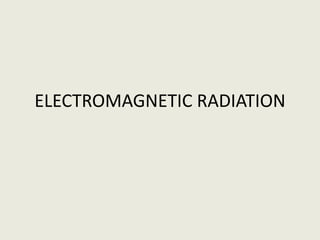
Electromagnetic radiation
- 2. Concept of Energy • It is the ability to do work • During work energy is transferred from one body to another and from one place to another • There are three ways in which energy can be transferred
- 3. Conduction: it occurs when one body (atom or molecule) collide with other Convection: energy is transferred from one place to another by physically moving the bodies Radiation: it is the only form of energy transfer that can take place in vacuum such as the region between the sun and the earth
- 4. Definition • EMR consisting of self-sustaining oscillating electric and magnetic fields at right angles to each other and to the direction of propagation. It does not require a supporting medium and travels through empty space at the speed of light or • EMR is a form of energy emitted and absorbed by charged particles which exhibits wave-like behavior as it travels through space. It propagates as wave motion at a velocity of c = 3 x 108 m/sec
- 5. Electromagnetic Radiation Production of electromagnetic radiation and its propagation through space and its interaction with other matter is explained by using wave model and particle model
- 6. Wave model • In 1860 J C Maxwell conceptualized EMR as an electromagnetic energy or wave that travels through space at the speed of light • Speed of light is 3 X 108 m/s • Electromagnetic waves consists of two fluctuating fields-one is electric and other is magnetic
- 7. The two fields are at right angles to each other and are perpendicular to the direction of propagation
- 8. 1) Amplitude – this is “how high” the wave is: 2) Wavelength () – this is the distance between two corresponding points on the wave and is measured in metres: 3) Frequency – number of cycles of a wave passing a fixed point per unit time and is measured in Hertz (Hz) The parameters that characterize a wave motion are “amplitude (a), wavelength (λ) and frequency (γ)”
- 9. • Wavelength: length of one complete wave cycle and it can be measured as distance between two successive crests • Crests: it is point on a wave with the greatest positive value or upward displacement in a cycle • Trough: is inverse of crest
- 11. • A crest is the point on a wave with the maximum value or upward displacement within a cycle • A trough is the opposite of a crest, so the minimum or lowest point in a cycle
- 12. General Properties of all electromagnetic radiation Electromagnetic radiation can travel through empty space. Most other types of waves must travel through some sort of substance. For example, sound waves need either a gas, solid or liquid to pass through in order to be heard. The speed of light is always a constant (Speed of light : 2.99792458 x 108 m s-1) Wavelengths are measured between the distances of either crests or troughs. It is usually characterized by the Greek symbol (λ) .
- 13. How do electromagnetic waves differ? Different electromagnetic waves carry different amounts of energy. For example, microwaves carry less energy that X-rays. The amount of energy carried by an electromagnetic wave depends on the wavelength: the shorter the wavelength, the higher its energy. Wavelength and frequency are linked properties of a wave: the shorter the wavelength, the higher its frequency. So, frequency also tells you about the energy of a wave: the higher its frequency, the higher the energy.
- 14. What happens when waves hit a surface? When electromagnetic waves hit a surface, they can be reflected, absorbed or transmitted. The waves behave, depends on their energy and the type of material. For example: light waves are reflected by skin but X-rays pass straight through. If electromagnetic waves are absorbed, some of their energy is absorbed by the material. This usually increases the temperature of the material.
- 15. Particle model • EM energy may also be described in terms of joules (J) and electron volts (eV) • Rate of transfer of energy from one place to another (sun to earth) is termed as the flux of energy • Flux means flow and is measured in watts • Light is a stream flow of particles called photons
- 16. • When matter excited thermally or by nuclear processes or by bombardment with other radiation photons are emitted • Photons move at the speed of light • Photons also exist as reflected or absorbed radiation • Amount of energy associated with a photon is determined as Q=hv • h=Planck’s constant (6.626X10-34J)
- 17. EMR is both wave and a stream of particles
Editor's Notes
- Boardworks GCSE Science: Physics Electromagnetic Waves
- Boardworks GCSE Science: Physics Electromagnetic Waves
